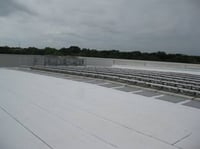When Roofs Become Much More Than Simple Roofs

By: Ken Ollinger RRC, RRO, CCCA, Austech Roof Consultants, Inc.
A decade ago the desire of most knowledgeable owners, designers, and contractors was to “keep it off the roof.” Finding that eliminating unnecessary foot traffic and equipment such as satellite dishes, antennas, piping, etc., was the first step in extending the roof’s useful service life, great efforts were made to limit these things on, as well as penetrations through, the roof. In recent history these simple roofs have evolved and the question now is this: “How can we use the roof surface effectively for other non-roof related functions?”
Roofs are now being used as the location for many functions that need to be designed and integrated into the roof system. Solar arrays, wind turbines, satellite antennas, commercial communication equipment and many other systems are now being installed on the roof. Roofs are also being designed and built to support various amenities such as garden or vegetated roofs, observation, recreation, and meeting areas. Restaurants use roof as additional outdoor dining areas, and the list of similar purposes goes on.
Other influences have been affecting roof design as well such as the U.S. Green Building Council’s LEED program, the EPA’s ENERGY STAR program, energy codes, along with environmental regulations and ongoing code changes. While these issues and requirements are beneficial, they can create a confusing list of requirements that contractors, designers and owners must be aware of and incorporate in new or replacement roof systems. These influences and requirements are contributing to the need for a greater degree of coordination between the team members to result in a successful project.
Project Planning
The first step of a successful project is planning. Each roofing project undertaken is unique and will have special issues that must be addressed, but there is a plethora of typical items that must go into the planning and design phase to result in a successful project. The considerations can include understanding the code requirements, insurance, uplift resistance, drainage, roof function, deck type, insulation, foot traffic, desired service life, annual maintenance, warranties, etc. While each one of these items can be regarded as a typical heading, each will have several subheadings and can be affected by the additional functions required of the roof.
When it is determined that the roof is being asked to be the platform for non-roof equipment or will be required to support some of the special functions described above, it is beneficial to begin a design checklist or matrix of those functions. The design considerations for each item can then be tracked. I suggest taking into account the design, typical construction, potential damage to the roof and maintenance of each non-roof item and then coordinate that information with the roof design as a whole.
One of the most important items of any successful project is constructability. At the end of the day the owner must have a project that can be built within the anticipated budget, support the non-roof functions, meet all of the requirements and remain watertight for the anticipated service life of the roof. Constructability for each project typically means coordination of all the design requirements for the roof and roof top functions to determine that each works and does not create a harmful effect on the other.
A Team Effort

Construction of today’s roofs must be a team effort. Contractors, owners, manufacturers and designers must maintain an open relationship to construct today’s complicated roof systems incorporating the desired non-roof functions. Manufacturers of the roof mounted equipment are often a good source of information regarding the requirements for their particular systems. They also must be made aware of the end requirements necessary to make the roof perform as desired for its anticipated service life while supporting their equipment. Roof membrane manufacturers are typically an excellent resource for warranty requirements, roof protection, code compliance and general roof installation information. Qualified and knowledgeable contractors are also a key element in successful projects. In today’s market, contractors must be versed in a multitude of roof systems and also be knowledgeable about the non-roof systems that are to be incorporated. In addition, the roof system must be integrated with the entire building envelope, so contractors must be versed in the nuances of coordinating the roof and building envelope. It is beneficial to open the dialogue with qualified contractors early to discuss systems, constructability, requirements, maintenance and probable costs.;
The entire team must understand the construction sequencing. Roofs are typically constructed to resist foot traffic and other abuse after construction, but when the roof is going to be used for other functions, the need for roof protection may be immediate to prevent damage during installation of other equipment and penetrations. The team must determine what the protection requirements are and who will provide the work.
A knowledgeable and cooperative team is also a great benefit during construction. While designers make every effort to provide a good set of complete details and construction documents, they cannot anticipate all of the sequencing and field modifications that may become necessary; therefore, the team approach is essential to make field decisions and provide modification documents in a timely manner as the need arises. Successful projects also benefit greatly from qualified construction observation. Qualified field observers commissioned by contractors, architects, engineers, owners and consultants become an integral part of the construction team.
Commissioning

In the current construction process, commissioning has become a key element for many projects. While commissioning is typically accomplished for the entire project, for this discussion the concentration is on the roof. While accomplishing the punch-list review, the roof system designer should consider the entire roof assembly including non-roof functions. When considering the roof as a platform, all of the items that affect the roof’s performance should be noted even though correction of some of those items will likely not be accomplished by the roof installer. Noting items that need to be completed by trades other than the roof installer on the roof punch-list report will indicate the importance of coordination and how each function will affect the others.
The primary function of the roof is to keep the facility watertight. Failure of owners, designers and contractors to keep that basic function in mind while achieving the larger goals will result in long-term problems, expensive repairs and a potentially reduced service life for the roof. The days of the “keep it off the roof” approach are rapidly fading into the sunset. Today, the roof is a valuable contributor to the building’s overall appearance as well as its environmental and energy performance. The team must “stay on top of the game” taking an all-encompassing approach to the roof design, construction, and management to result in watertight, long-term performance while supporting the other non-roof functions desired.
REFERENCES:
Thomas W. Hutchinson, AIA, CSI, FRCI, RRC presentation at RCI Convention “Roof as a Platform”
Biasell, Natasha “Innovative Roofing Inspires Solar Energy Collaboration.” RCI Interface July 2009
Ken is a Senior Consultant with Austech Roof Consultants, Inc. in Austin, Texas. Austech was established in 1984 and has offices in both Austin and San Antonio, Texas. Austech specializes in roofing, waterproofing and building envelope technology. Austech provides Construction Documents, Reports, Moisture Surveys, Quality Control Monitoring, Design Reviews, and Expert Testimony on both new and retrofit projects. Ken can be reached at 512-443-7255 or ken@austechrci.com.
Subscribe Today!
Stay-in-the-know and subscribe to our blog today!